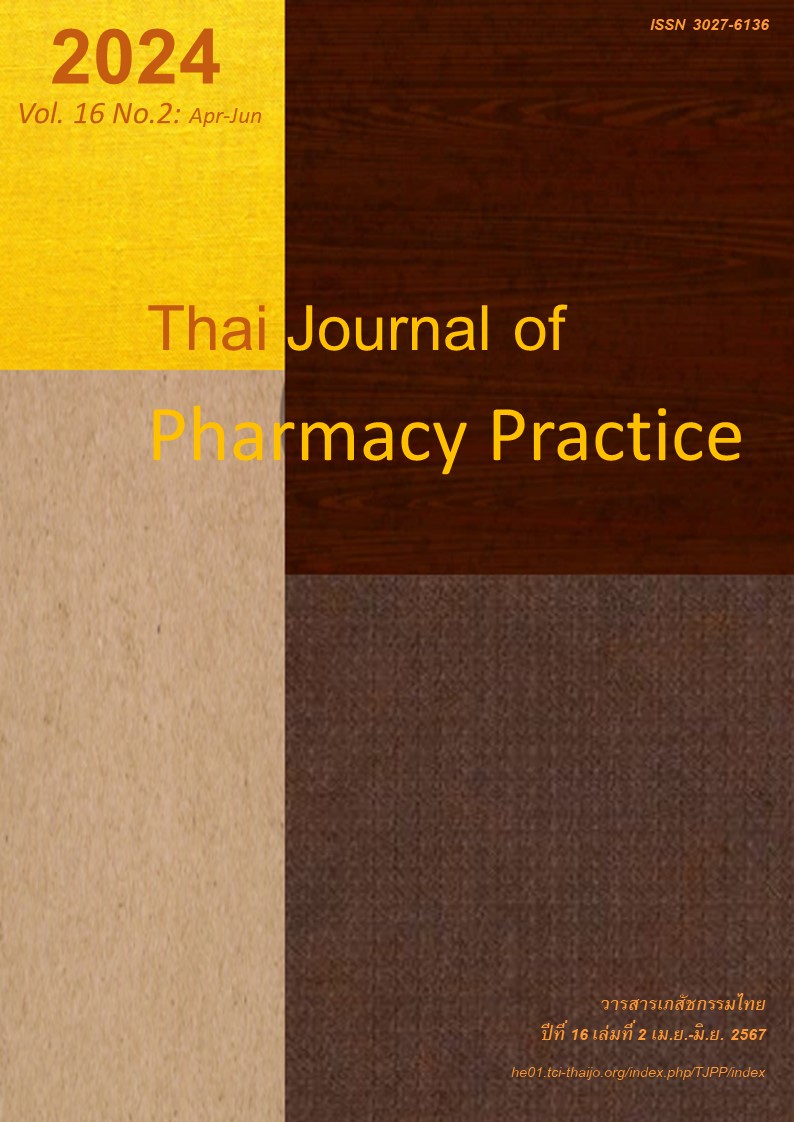การพัฒนาและการประเมินแบบวัดความรู้เกี่ยวกับการบริโภคอาหาร อย่างสมดุลสำหรับนักศึกษามหาวิทยาลัยชาวกัมพูชา
Main Article Content
บทคัดย่อ
วัตถุประสงค์: เพื่อพัฒนาและประเมินแบบวัดความรู้เกี่ยวกับการบริโภคอาหารอย่างสมดุล (the Knowledge Test on Balanced Diet Consumption: KTBDC) สำหรับนักศึกษาชาวกัมพูชาที่สร้างขึ้นจากคำแนะนำการการบริโภคอาหารอย่างสมดุลขององค์การอนามัยโลก วิธีการ: ผู้วิจัยได้พัฒนาแบบวัดความรู้จากการทบทวนวรรณกรรมและการสัมภาษณ์กลุ่มตัวอย่างนักศึกษากัมพูชาแบบซึ่งหน้า แบบวัด KTBDC ที่พัฒนาขึ้นมีคำถามจำนวน 25 ข้อ ซึ่งมีเนื้อหาครอบคลุมในประเด็นความรู้ทั่วไปเกี่ยวกับคำแนะนำในการบริโภคอาหารอย่างสมดุล การเปรียบเทียบแคลอรี่ และการประมาณปริมาณของคาร์โบไฮเดรท โปรตีน ไฟเบอร์ในอาหาร คำตอบของคำถามแต่ละข้อเป็นแบบ 3 ตัวเลือก คือ “ใช่” “ไม่ใช่” และ “ไม่ทราบ” คำถามแต่ละข้อได้รับการประเมินความตรงเชิงประจักษ์ และความตรงตามเชิงเนื้อหาด้วยดัชนีความสอดคล้องระหว่างข้อคำถามกับวัตถุประสงค์ (item objective congruence index: IOC) โดยผู้เชี่ยวชาญ จำนวน 3 คน หลังจากนั้น นักศึกษามหาวิทยาลัยระดับปริญญาตรีในกัมพูชาจำนวน 95 คนตอบแบบสอบถาม KTBDC การศึกษาคำนวณดัชนีความยาก (Pi) และดัชนีอำนาจการจำแนก (Di) ของข้อคำถามรายข้อ และคำนวณดัชนีความยากและดัชนีอำนาจการจำแนกของภาพรวมของแบบวัด KTBDC จากค่าเฉลี่ยดัชนีความยากรายข้อ () และค่าเฉลี่ยดัชนีอำนาจการจำแนก () ตามลำดับ ความเที่ยงของแบบวัดความรู้ประเมินโดยค่า Kuder-Richardson 20 (KR-20) ผลการวิจัย: กลุ่มตัวอย่าง 50 ราย (ร้อยละ 52.6) เป็นเพศหญิง ค่าเฉลี่ยอายุของตัวอย่างเท่ากับ 22.3±1.9 (พิสัย:18-27) ปี ข้อคำถามทั้ง 25 ข้อมีค่า IOC > 0.5 ดัชนีความยากโดยรวมของแบบวัด KTBDC อยู่ในระดับปานกลาง (: 0.49) และดัชนีอำนาจจำแนกโดยรวมอยู่ในระดับดีเยี่ยม ( >0.67) ความเที่ยงเท่ากับ 0.92 สรุป: แบบวัด KTBDC มีความตรงตามวัตถุประสงค์ของการประเมินและความสม่ำเสมอของคำถามในแบบวัดอยู่ในระดับที่สูง ซึ่งบ่งชี้ว่า แบบวัดมีความตรงและความเที่ยงในการประเมินความรู้เกี่ยวกับการบริโภคอาหารอย่างสมดุลในกลุ่มนักศึกษามหาวิทยาลัยชาวกัมพูชา การศึกษาในอนาคตควรเน้นในเรื่องความสามารถขยายผลเพื่อนำแบบวัดไปใช้ในปะชากรกลุ่มอื่นและบริบทอื่น เพื่อให้มั่นใจว่า แบบวัดสามารถประยุกต์ใช้ได้ในวงกว้าง
Article Details

อนุญาตภายใต้เงื่อนไข Creative Commons Attribution-NonCommercial-NoDerivatives 4.0 International License.
ผลการวิจัยและความคิดเห็นที่ปรากฏในบทความถือเป็นความคิดเห็นและอยู่ในความรับผิดชอบของผู้นิพนธ์ มิใช่ความเห็นหรือความรับผิดชอบของกองบรรณาธิการ หรือคณะเภสัชศาสตร์ มหาวิทยาลัยสงขลานครินทร์ ทั้งนี้ไม่รวมความผิดพลาดอันเกิดจากการพิมพ์ บทความที่ได้รับการเผยแพร่โดยวารสารเภสัชกรรมไทยถือเป็นสิทธิ์ของวารสารฯ
เอกสารอ้างอิง
World Health Organization. WHO nutrient profile model for South-East Asia Region. Genva: World Health Organization; 2017.
Sophal O, Piseth RP, Eng MK, Vannareth M, Sothea A, Youttiroung B, et al. Prevalance of non-communicable disease risk factors in Cambodia, STEPS survey, Country report; 2010. Phnom Penh, Cambodia: University of Health Sciences. Available from: https://extranet.who.int/ncdsmicrodata/index.
php/catalog/378/download/2863
Stok FM, Renner B, Clarys P, Lien N, Lakerveld J, Deliens T. Understanding eating behavior during the transition from adolescence to young adulthood: A literature review and perspective on future research directions. Nutrients. 2018; 10: 667. doi: 10.3390/nu10060667.
Crombie AP, Ilich JZ, Dutton GR, Panton LB, Abood DA. The freshman weight gain phenomenon revisited. Nutr Rev 2009; 67: 83-94.
Racette SB, Deusinger SS, Strube MJ, Highstein GR, Deusinger RH. Changes in weight and health behaviors from freshman through Senior year of college. J Nutr Educ Behav 2008; 40: 29-42.
Vella-Zarb RA, Elgar FJ. The ‘Freshman 5’: A meta-analysis of weight gain in the freshman year of college. Am Coll Health 2009; 58: 161-6.
Mokdad AH, Serdula MK, Dietz WH, Bowman BA, Marks JS, Koplan JP. The spread of the obesity epidemic in the United States, JAMA 1999; 282: 1519-22.
Sogari G, Velez-Argumedo C, Gómez MI, Mora C. College students and eating habits: A study using an ecological model for healthy behavior. Nutrients 2018; 10: 1823. DOI: 10.3390/nu10121823.
Wang J. A behavioral model for analysis and intervention of healthy dietary behavior. Glob J Health Sci. 2020; 12: 57. DOI: 10.5539/gjhs.v12n 4p57.
Lok B, McNaught C, Young K. Criterion-referenced and norm-referenced assessments: compatibility and complementarity. Assess Eval High Educ 2016; 41: 450-65.
Great Schools Partnership. Criterion-referenced test definition [online]. 2014 [cited Mar 16, 2023]. Available from: www.edglossary.org/criterion-referen ced-test/
Turner RC, Carlson L. Indexes of item-objective congruence for multidimensional items. Int J Test 2003; 3: 163-71.
Siltrakool B. Assessment of community pharmacists ’ knowledge , attitude and practice regarding non-prescription antimicrobial use and resistance in Thailand [master thesis]. Bangkok: Chulalongkorn University; 2018.
Perneger T V, Courvoisier DS, Hudelson PM, Gayet-Ageron A. Sample size for pre-tests of questionnaires. Qual Life Res 2015; 24: 147-51.
Backhoff E, Larrazolo N, Rosas M. The level of difficulty and discrimination power of the basic knowledge and skills examination [online]. 2000 [cited Mar 16, 2023]. Available from: redie.uabc.mx/ vol2no1/contents-backhoff.html
Azzopardi M, Azzopardi C. Relationship between item difficulty level and item discrimination in biology final examinations [online]. 2019 [cited Mar 16, 2023]. Available from: end-educationconference.org /2019/wp-content/uploads/2020/05/2019v2end001. pdf
Welkowitz J, Cohen BH, Lea RB. Introductory statistics for the behavioral sciences. 7th ed. Hoboken, NJ: John Wiley &Sons; 2012.
OECD 2012. Translation and verification of the test and survey material [online]. 2012 [cited Mar 16, 2023]. Available from: www.oecd-ilibrary.org/educa tion/pisa-2009-technical-report/translation-and-verifi cation-of-the-test-and-surveymaterial_97892641678 72-6-en


